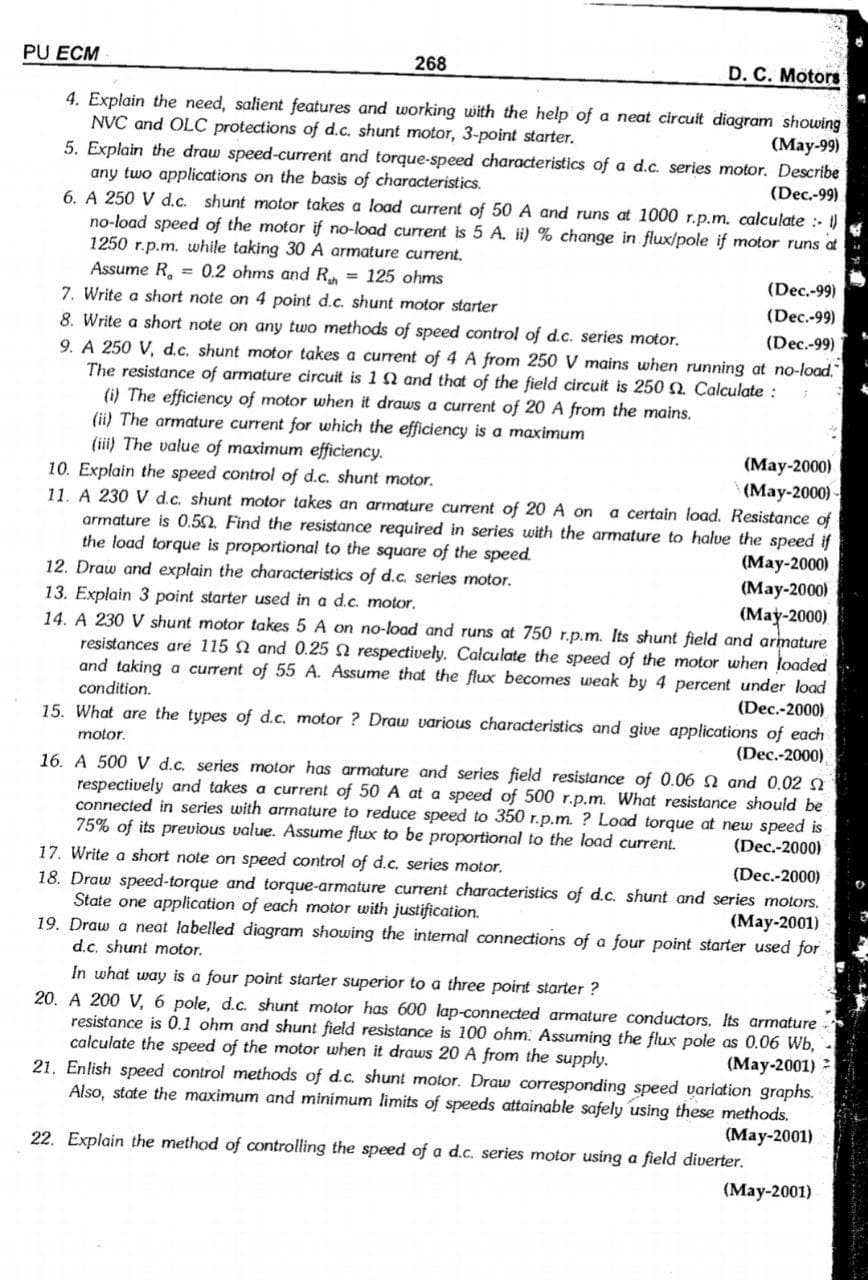4. Explain the need, salient features and working with the help of a neat circuit diagram showing NVC and OLC protections of d.c. shunt motor, 3-point starter. (May-99) Expl
4. Explain the need, salient features and working with the help of a neat circuit diagram showing NVC and OLC protections of d.c. shunt motor, 3-point starter. (May-99) Expl
Introductory Circuit Analysis (13th Edition)
13th Edition
ISBN:9780133923605
Author:Robert L. Boylestad
Publisher:Robert L. Boylestad
Chapter1: Introduction
Section: Chapter Questions
Problem 1P: Visit your local library (at school or home) and describe the extent to which it provides literature...
Related questions
Question

Transcribed Image Text:PU ECM
268
D. C. Motors
4. Explain the need, salient features and working with the help of a neat circuit diagram showing
NVC and OLC protections of d.c. shunt motor, 3-point starter.
5. Explain the draw speed-current and torque-speed characteristics of a d.c. series motor. Describe
any two applications on the basis of characteristics.
6. A 250 V d.c. shunt motor takes a load current of 50 A and runs at 1000 r.p.m. calculate : )
no-load speed of the motor if no-load current is 5 A. i) % change in flux/pole if motor runs at
1250 r.p.m. while taking 30 A armature current.
Assume R, = 0.2 ohms and R = 125 ohms
7. Write a short note on 4 point d.c. shunt motor starter
(May-99)
(Dec.-99)
(Dec.-99)
(Dec.-99)
8. Write a short note on any two methods of speed control of d.c. series motor.
9. A 250 V, d.c. shunt motor takes a current of 4 A from 250 V mains when running at no-load.
The resistance of armature circuit is 1 Q and that of the field circuit is 250 Q Calculate:
(i) The efficiency of motor when it draws a current of 20 A from the mains.
(ii) The armature current for which the efficiency is a maximum
(iii) The value of maximum efficiency.
(Dec.-99)
(May-2000)
(Мay-2000)
10. Explain the speed control of d.c. shunt motor.
11. A 230 V d.c. shunt motor takes an armature current of 20 A on a certain load. Resistance of
armature is 0.52. Find the resistance required in series with the armature to halve the speed if
the load torque is proportional to the square of the speed.
12. Draw and explain the characteristics of d.c. series motor.
13. Explain 3 point starter used in a d.c. motor.
14. A 230 V shunt motor takes 5 A on no-load and runs at 750 r.p.m. Its shunt field and armature
resistances are 115 2 and 0.25 n respectiveły. Calculate the speed of the motor when loaded
and taking a current of 55 A. Assume that the flux becomes weak by 4 percent under load
condition.
(Мay-2000)
(May-2000)
(May-2000)
(Dec.-2000)
15. What are the types of d.c. motor ? Draw various characteristics and give applications of each
(Dec.-2000)
motor.
16. A 500 V d.c. series motor has armature and series field resistance of 0.06 N and 0.02
respectively and takes a current of 50 A at a speed of 500 r.p.m. What resistance should be
connected in series with armature to reduce speed to 350 r.p.m. ? Load torque at new speed is
75% of its previous value. Assume flux to be proportional to the load current.
(Dec.-2000)
17. Write a short note on speed control of d.c. series motor.
18. Draw speed-torque and torque-armature current characteristics of d.c. shunt and series motors.
State one application of each motor with justification.
19. Draw a neat labelled diagram showing the intemal connections of a four point starter used for
d.c. shunt motor.
In what way is a four point starter superior to a three point starter ?
20. A 200 V, 6 połe, d.c. shunt motor has 600 lap-connected armature conductors. Its armature
resistance is 0.1 ohm and shunt field resistance is 100 ohm: Assuming the flux pole as 0.06 Wb,
calculate the speed of the motor when it draws 20 A from the supply.
21. Enlish speed control methods of d.c. shunt motor. Draw corresponding speed variation graphs.
Also, state the maximum and minimum limits of speeds attainable safely using these methods.
(Dec.-2000)
(May-2001)
(May-2001) 2
(May-2001)
22. Explain the method of controlling the speed of a d.c. series motor using a field diverter.
(May-2001)
Expert Solution
This question has been solved!
Explore an expertly crafted, step-by-step solution for a thorough understanding of key concepts.
Step by step
Solved in 2 steps with 1 images

Knowledge Booster
Learn more about
Need a deep-dive on the concept behind this application? Look no further. Learn more about this topic, electrical-engineering and related others by exploring similar questions and additional content below.Recommended textbooks for you

Introductory Circuit Analysis (13th Edition)
Electrical Engineering
ISBN:
9780133923605
Author:
Robert L. Boylestad
Publisher:
PEARSON

Delmar's Standard Textbook Of Electricity
Electrical Engineering
ISBN:
9781337900348
Author:
Stephen L. Herman
Publisher:
Cengage Learning

Programmable Logic Controllers
Electrical Engineering
ISBN:
9780073373843
Author:
Frank D. Petruzella
Publisher:
McGraw-Hill Education

Introductory Circuit Analysis (13th Edition)
Electrical Engineering
ISBN:
9780133923605
Author:
Robert L. Boylestad
Publisher:
PEARSON

Delmar's Standard Textbook Of Electricity
Electrical Engineering
ISBN:
9781337900348
Author:
Stephen L. Herman
Publisher:
Cengage Learning

Programmable Logic Controllers
Electrical Engineering
ISBN:
9780073373843
Author:
Frank D. Petruzella
Publisher:
McGraw-Hill Education

Fundamentals of Electric Circuits
Electrical Engineering
ISBN:
9780078028229
Author:
Charles K Alexander, Matthew Sadiku
Publisher:
McGraw-Hill Education

Electric Circuits. (11th Edition)
Electrical Engineering
ISBN:
9780134746968
Author:
James W. Nilsson, Susan Riedel
Publisher:
PEARSON

Engineering Electromagnetics
Electrical Engineering
ISBN:
9780078028151
Author:
Hayt, William H. (william Hart), Jr, BUCK, John A.
Publisher:
Mcgraw-hill Education,